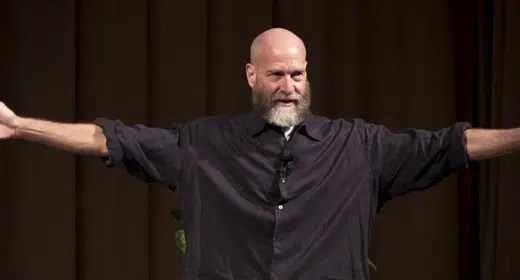David Deida’s 1997 book The Way of the Superior Man: A Spiritual Guide to Mastering the Challenges of Women, Work, and Sexual Desire
has all but become required reading for anyone entering the modern discourse and practice of men’s work… Selling over a quarter of a million copies and still ranking at the top of numerous Amazon categories, the book is a treatise on masculine spiritual development and intimacy that lays down a life altering possibility for men committed to deepening in their spiritual and sexual lives. It certainly changed my life, along with countless other men I know. In terms of impact and longevity, it stands head and shoulders above any other book in the space, including men’s work classics like Robert Bly’s Iron John and Sam Keene’s Fire in the Belly.
In relatively short but dense chapters, Deida lays out a series of axioms and challenges to men facing the unique socio-historical and spiritual challenges alive at the turn of the millennia. He point-blank tackles questions such as how to celebrate and navigate the innate energetic differences between humans with a primarily masculine, versus a primarily feminine essence; how to find and live your life’s deepest purpose; how to own your dark emotional and sexual nature in service of love; and how to nourish and cultivate your internal masculine traits in the shadow of post-feminism and the responsibilities of modern living.
Chapters like Know Your Real Edge and Don’t Fake It, She Wants the Killer in You, and If You Don’t Know Your Deepest Purpose, Find it Now are perfect examples of Deida’s direct approach to putting men in touch with the most important issues they will face as they mature spiritually, emotionally and sexually.
The book and his corresponding workshop trainings provided an explanation to now two generations of confused men, many of whom didn’t understand why getting more in touch with their feelings and allowing their feminine partners to assume more of a leadership role in the relationships didn’t actually lead to more trusting, nourishing, and connected sexual intimacy. In fact, more and more often, it led to bitterness and resentment from their feminine partners in ways that were completely unexpected.
“Like a slap to the third eye, Deida spoke to what so many men felt, but didn’t have the skillset or awareness to name.”
Like a slap to the third eye, Deida spoke to what so many men felt, but didn’t have the skillset or awareness to name. Coming out of the cultural shifts of the 70’s, 80’s and 90’s, many men learned how to get in touch with a deeper experience of feeling and creativity, as well as sexual, social and spiritual freedom. Much of the men’s work of this time focused on helping men feel more and be less constrained by the patriarchal norms foisted upon them throughout the previous generations.
This capacity and freedom to feel and express themselves, however, came at the cost of an internal sharpness and clarity, which then led to confusion in their romantic relationships and spiritual approaches to life. So many men, including myself, entered the turn of the millennia believing that success in the world would come from working hard and boldly pursuing their dreams; while romantic relationships would naturally flourish from being a man of sensitivity and emotional awareness; as well as a good provider, loving father, and most importantly, an ardent supporter of their partner’s career and dreams.
TWOTSM busted this “myth of the good husband” wide open and laid a true framework for depth and success in a way that few men had ever heard. The work struck such a chord that much of the language used in TWOSM and other Deida teachings is now commonplace among therapists, coaches, and would-be teachers of men’s work, spiritual intimacy, and yogic sexuality. Terms like sexual polarity, masculine/feminine, sexual yoga, life’s purpose and even presence have taken on new significance thanks to the framework of growth and intimacy he mapped out. It would be impossible to write a book on masculine spiritual development, sexual polarity, or masculine leadership without relying heavily on the groundbreaking work Deida presents.
This book is no exception. In fact, my exploration of what it has meant to me—to lead my romantic relationships as a so-called conscious, embodied man and in many ways, my strong impulse to lead men’s groups—was sparked by the challenge presented in TWOTSM.
If I was clear that the roles of “provider,” “partner,” and “father” were not the end-all, be-all, but simply the starting point from which a spiritually fulfilling and passionate relationship would grow, then what else was being called for?
What were my responsibilities in leading, holding space, and directing my feminine partner into the most nourishing connection and bliss beyond simply being a turned on woman?
How could I animate, amplify and embody the traits of love and consciousness in ways that my partner and the world could feel, relax with, and trust? How could my life itself become a practice of elevating love so profoundly that the consciousness of the planet was raised, not in some esoteric manner, but as an expression of true depth and feeling that others could immediately see? And why was this level of excruciating practice even necessary?
Wasn’t being a good man, a good provider, and a good father enough? There was nothing about embodied consciousness, purpose, or sexual polarity in the cultural discourse around manhood as I was growing up. And yet, Deida laid out with painstaking clarity that real success in love and life depended on our capacity as men to cultivate these traits and skills exactly.
The most troubling question to me, and countless other men I have worked with since then, was, “Why am I responsible for leading this emotional, spiritual, and sexual up-leveling?” Hadn’t we just been told for thirty years to relinquish our grip on leadership? Weren’t relationships supposed to be co-lead? Well, it turns out, yes and no. What I learned in my 12 years of study and thousands of hours of training in spiritual intimacy with Deida was simply this:
If I wanted to be a deeply trusted masculine presence in my relationship; if I wanted my feminine partner to truly experience and surrender the totality of her free and wild heart; and if I wanted to create the kind of sexually charged love affair that most humans dream of, then the burden of spiritual depth, emotional clarity, and sexual practice fell onto me.
Deida calls out this challenge of leadership in two lesser known chapters at the end of the book that caught my attention, and kept it. These chapters—You Are Responsible for the Growth in Intimacy and Insist on Practice and Growth—threw down the gauntlet for any and all men who wanted to create relationships squarely focused on depth, spiritual growth, and unconditional love, not just security and comfort. It certainly spoke to tens of thousands who intuited deep down that there was a more noble, creative, generous, passionate, and artful way to be in the world than they had been taught.
Yet it flew directly in the face of what men had been told: Women wanted to be allowed to lead themselves and make their own decisions in love and life. They did not want to be directed by what “men thought was best.”
It also challenged men to develop a set of romantic leadership skills and capacities that most men intuited was important, but did not know how to create, let alone sustain. Could I really meet her criticism with playful humor and flirty banter so that she melted in my arms?
Could I learn to live my life with such meticulous integrity that my presence would be a healing force in her life, allowing her to relax more into her feminine essence?
Could I learn to circulate sexual energy so skillfully that our love-making would become a spiritual practice? Could I lead my own life, mission, and romantic relationships from a level of personal depth that inspired sincere trust from my lover and the world?
Deida presented these possibilities quite matter-of-factly, laying out these skills as if he were telling us to go down to the store and grab a carton of milk. Yet most men, including myself, came to find that becoming a Superior Man required a mastery that seemed nearly impossible to cultivate. What was needed was a level of awareness that was other-worldly, a creativity in their personal expression that could disarm any moment, a strong and supple nervous system that could hold incredible amounts of feminine sexual and emotional energy, an ability to open their nervous system in such a way that years of defensiveness and reactivity would relax into loving presence, and a stamina that was truly warrior-like.
“My initial thought, and the response of many men I have worked with over the years, was ‘well, that sounds great, but how the fuck do I do that?’”
My initial thought, and the response of many men I have worked with over the years, was, “Well, that sounds great, but how the fuck do I do that?”
Don’t get me wrong, Deida describes, albeit in broad strokes, the pathway required. And in his workshops and one-on-one trainings, he goes much deeper into the detailed and meticulous practices needed to bring an immediate, yogic shift. But unless one truly dedicated themselves to that level of training—similar to, say, what a martial artist would have to do to obtain a black belt—then building a sustainable householder practice proved very difficult. Without a powerful momentum, people would just revert to their lifelong habits of relating, sexing, and being in the world. So few took the time to cultivate the nervous system strength, the depth of self awareness, or the training needed to actually put those teachings into practice.
It was as if Deida said, “Come climb this treacherous, awe-inspiring mountain with me. You will feel fully alive and aligned to the core of who you are in ways you never imagined possible. I will give you the map, but the journey will require you to change virtually everything in your life and possibly break you. You will have to meticulously and painstakingly address your childhood wounds, your body-mind limitations, and your personal karma with the bravery, devotion, and stamina of a mythological warrior. Or, you can go back to sleep.”
The book is not titled The Way of the Really Good Guy for a reason.
And so… as if being pulled by a magnet, intrigued by the possibility revealed in that book and his many others, I became an ardent, if imperfect, practitioner of David’s work. I spent 12 years going to countless workshops, reading and listening to everything I could get my hands on, assisting at numerous co-ed and men’s intensives, starting and leading my own Deida-style men’s groups, and studying with anyone who David had trained.
I started men’s groups to study and practice the TWOTSM dharma, trying to bring it into the practical space of day-to-day living as a father, husband, son, and would-be leader of men. I was a householder and business owner, remember, not a monk in Dharamshala. I knew there must be ways to bring this sublime understanding of spiritual intimacy into the realm of ordinary living. I knew there was a way to make leading or co-leading my relationships an art. I knew there was a way to awaken into a more present, open and grounded way of showing up as a father to my daughter. I knew sex could be more artful and spiritually grounded; dark and yet heartbreakingly tender. I knew there was a historical moment arising that would allow for healing between men and women that transcended gender—and I wanted to be part of it.
My development as a practitioner was not pretty. I struggled with ego, immaturity, and confusion over how to use my newfound sexual power, and the capacity to stay with the feelings that arose from such deep work. I saw countless other men inspired to lead their relationships from a place of love, depth, and consciousness struggle to enact these principles Deida presented in his writings and workshops with such seeming ease. The personal and cultural programming, not to mention habits of reactivity, just ran too deep. And the emotional stamina and awareness needed!! No wonder most of them gave up. Many men I saw got side-swiped by childhood pain and that made “living open as love” impossible. It was as if the bar was so high that most men found it an impossible journey to continue.
What Deida did not tell us was that as soon as we began to truly practice the yogic and meditative ways of the Superior Man, much if not all of our childhood wounds and programming would bubble to the surface and make staying open in the midst of love’s challenges incredibly painful. Sure, there were immediate benefits such as deeper sex and more sublime romantic connection that came with the breath and embodiment work. But at some point, we were forced to face our personal and familial karmas—an invitation that would require those who wanted to stay to raise their bar of commitment to a whole new level. Many bailed out after a year or two of practice. As their core wounds began to rise, I watched them fall away one-by-one, never to return.
Somewhere along the way, however, I came to a realization that changed everything for me.
“These were not destinations, but journeys — filled with failure, fatigue, and recommitments.”
Like Deida had been saying all along, TWOTSM is a Yoga, just like any other set of Asana or Kriya. It was not meant to be completed, but to be continually reached for and deepened.
These were not destinations, but journeys — filled with failure, fatigue, and recommitments — just as with any traditional yogic practice.
And similarly, the poses required multiple gestures happening simultaneously, often in different directions. The exercises, concepts, and frameworks presented were perpetual openings towards a new way of being, relating, and loving in the world. This is where so many men went wrong. The ways described were never-ending Kriya that anyone could start to understand and practice. And the Yoga of Intimacy, I learned, was by far the deepest and most perilous. For as long as we live, we are always in an intimacy, whether it be to the space we are in, to the world at large, to our communities and families, or to the moment. It never stops. The journey was the goal, as Chogyam Trungpa would say. There was no arrival.
Each practitioner, of course, would bring their own limitations, histories, karmas, childhood traumas and body-mind habits to the table. But as long as a man or woman wanted to know the sublime beauty of loving from consciousness, the door was open. All that was required was a willingness to open, a no-bullshit dedication to practice, and a humility to learn and grow. It had to be consistent over the years.
The work of perpetual openness did not follow the typical model of personal development. It was not about state-induced growth, so much as commitment to a “lifelong” practice of relaxing, resting, and loving as consciousness. There was no weekend workshop or afternoon process that would change lifetimes of habits or genetic imprinting that one brings to their lovers and the world. It was a karmic and non-linear path that often had incredible obstacles placed in the way. Once I realized this, I could take a more relaxed, bird’s eye view of the journey.
Most great yogis, or artists for that matter, don’t practice their art for a year and then give it up. They continue to morph, develop, and expand creatively based on the impulses wanting to move through them. The Masculine Yoga of depth, presence, and openness is no different. It can and should be practiced daily, multiple times a day, or even better, moment-to-moment.
The fact that there is no end to the work actually fucks up a lot of men, as the masculine longs for a simple roadmap to all endeavors which will end in glorious and celebratory completion. Mastery. Checked off bucket-list experiences. That is impossible in this work.
The Yoga of Masculine Depth is a never-ending edge-hunting and dedication to expanding one’s nervous system capacity that continues to deepen the practitioner. Twelve years into my practice and I am still fed the humble pie of my limitations daily. And yet, there is nothing else I would rather do with my life.
There are still some who reject the discussion of masculine/feminine polarities and energetic duality altogether. In many circles, the talk of gender-oriented tendencies is distasteful. The framework is too rigid, as to almost be insulting to the gender-neutral, socio-cultural landscape that has emerged over the last decade. These attacks often lack the sophistication to understand the nuances of masculine/feminine tendencies in all humans. They will just assume that masculine only means men, and feminine only means women. And so, they claim the work patriarchal. These attacks on Deida’s work have not really grown any teeth. It’s proven too hard to attack a meticulously laid-out call for more depth, love, and consciousness. Even if the language is still heteronormative.
As time has passed, and more and more people have come to accept that masculine and feminine energies live in all humans, transcending gender and sexual orientation, a new understanding is arising. It is common for men to celebrate and nourish their own emotional natures and desire for pleasure, love and connection; and for women to celebrate their drive for economic, sexual and spiritual freedom. And yet, more and more are recognizing the need to come back together sexually and emotionally through and as their core essences, be them masculine, feminine, or some form of balanced, fluid expression. In addition, polarity practices have become more nuanced over the last twenty years, taking into account how many people fluidly move between masculine and feminine ways of being in the world and in their relationships daily.
In my own work, I have taken great pains to explore how the sacred and healthy masculine can be deepened in a primarily feminine-identified being, and visa-versa. Any woman who desires can absolutely use the principles and practices in this book to consciously lead from her masculine. Any man can learn to transmit massive amounts of love and pleasure through his body, at any moment, in service to love. This is how we need to evolve.
A new generation of teachers, including myself, have tried to interpret and apply many of these offerings to householders and yogis on a greater scale, often with very clumsy, and sometimes disastrous results. Yet the work has penetrated the modern psyche at such a deep level, and the problem of relationship and fulfillment is so pernicious, it will be impossible to stop men and women from trying to share the framework of sexual polarities Deida has introduced. It would be similar to asking physicists and scientists in the 20th century to ignore Einstein. Not going to happen.
Like any revelatory and ground-breaking concept, legions of aspiring practitioners and innovators will attempt to expand on the practices and concepts Deida has presented throughout his prolific body of work. The demand and need for new technologies of relating is only growing. All we can hope to do is provide some level of integrity and accountability to the source material, while approaching with sensitivity everything that still needs to be said.
In many ways, The Art of Masculine Leadership is the story of my journey to living into the principles within the TWOTSM as a father, businessman, yogi, and teacher, while also appreciating the limits of the model Deida presented. The conscious practice community (which Deida describes so fully in his book Wild Nights) from which these teachings were born is almost impossible to re-create in the real world. So creating a householder’s paradigm of practice is paramount. It is also clear that the discourse of masculinity, femininity, and sexual polarity is becoming extremely nuanced; and that questions of gender fluidity, power dynamics, and sexual politics are going to need to be accounted for as a part of the shifting terrain of modern relating.
The #metoo movement shed a harsh spotlight on the masculine/feminine power dynamics created by the world patriarchy. Simultaneously, it begs for a new paradigm of masculine sensitivity, leadership and depth that can heal the wounds women are now revealing with aching vulnerability, on nearly every social media platform available.
Gender politics aside, women are still asking, often with more clarity, desperation, and desire than ever, that men meet The Feminine they have been struggling to reconnect with and reveal — meet her sexually, emotionally, energetically, politically, economically, and romantically. If men can activate their hearts, deepen their intentionality, and cultivate a meticulous skillset of openness, sensitivity and awareness, then they can meet this moment powerfully.
This is perhaps why the concept of Masculine Leadership has captivated me so — because at this crucial period in the history of love, not to mention humanity, we desperately need a practical, tangible, awakened form of conscious, clear Masculine Leadership. In men and women. The toxic, hard-driving, success oriented Masculine emulated by certain elements of feminism is no better when presented through a woman’s body. The new paradigm of masculinity must start in our way of being, versus our capacities as producers, providers, and protectors. That simply has not fostered the consciousness needed to move us forward as a species. A new transmission of masculinity has to replace it. One that prioritizes the connection to and expression of movement as consciousness in the world.
As I have learned, staying on this path will require an unshakeable commitment. That of a man determined to walk through a wall. One that most men (and women for the matter) will struggle to truly embody. Yet, it is still the Way.

















































